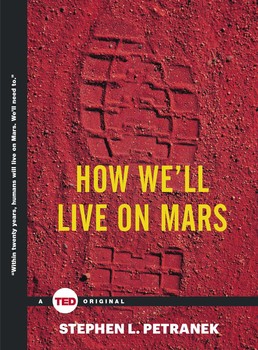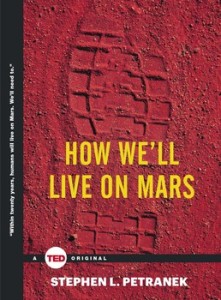New Books for Future Mars Settlers
There are two new and invaluable books on Mars, both of them ideal for those ready to settle down on the Red Planet:
– How We’ll Live on Mars by Stephen Petranek
– The International Mars Research Station – An exciting new plan to create a permanent human presence on Mars authored by Shaun Mark Moss.
Stephen Petranek is a career writer spanning some 40 years of publishing on science, nature, technology and politics.
How We’ll Live on Mars is a blend of those themes, nicely packaged in a nine chapter book that is well-written and researched – it’s a sheer delight to read.
TED Books is under the Simon & Schuster brand name, with this volume containing a mid-section of stunning color images.
For those still edgy about trekking to Mars, you’ll find this book comforting. The author tackles a number of “big questions” such as radiation factors and the microgravity effects of space travel on the human body – and adapting to Mars’ low gravity.
In the book, there’s a healthy dose of Elon Musk’s campaign to send humans to Mars. In addition, you’ll find some interesting discussion of terraforming the Red Planet to make Mars in Earth’s image.
This book is a unique blend of observations, bracketing the author’s view that within twenty years, humans will live on Mars.
“When the first humans set foot on Mars, the moment will be more significant in terms of technology, philosophy, history, and exploration than any that have come before it…we will no longer be a one-planet species.”
For ordering information, click here.
To read about Petranek’s TED Talk about colonizing Mars, click here.
Shaun Moss is an Australian computer scientist and also director of Mars Society Australia. He makes the case that settling Mars and becoming a multi-planetary species will be one of the most important steps in human evolution.
Within its 300 pages, The International Mars Research Station is alive with technical detail.
As Moss notes, the book is an exercise in aerospace engineering. The volume is loaded with creative ideas all adding up to blueprinting a near-term affordable and achievable way to send multiple international crews to Mars – and return them home safe and sound.
What I found appealing is Moss calling attention to the SpaceX Falcon 9 and Dragon capsule designs, as well as the use of expandable modules by Bigelow Aerospace.
The attention to detail – from crafting international partnerships and food production to using local Martian resources and space suit requirements – makes this book a true treasure. While being a technical tour-de-force of ideas, Moss paints a clear picture of the needed pieces to send crews to Mars and sustain a human presence there.
Moss has done an impressive amount of research for this book. Even the most seasoned Mars architect will find this volume a very useful and informative resource.
For book ordering information, click here.
For a Slashdot.org article on Moss and this how-to-do-it book, click here.
By Leonard David



